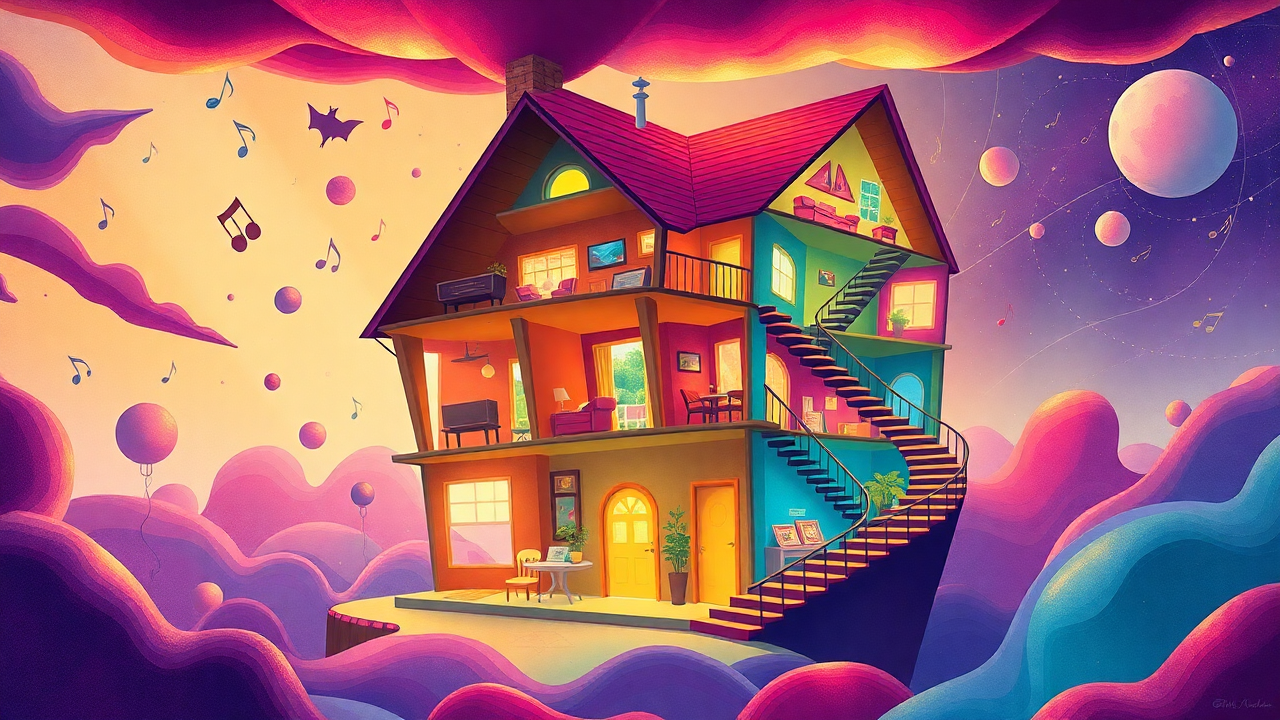Introduction
Ken Nordine, an American voiceover artist, poet, and pioneer of the avant-garde word jazz genre, was a master of creating surreal experiences through his work. One of the most intriguing and whimsical creations that emerged from his vast imagination is the concept of the Topsy Turvy House Ken Nordine. Through vivid descriptions and a playful approach, Nordine gave birth to a concept that has fascinated listeners and artists alike for decades. This article explores the Topsy-Turvy House, its significance, its symbolism, and the broader implications it holds in the context of Nordine’s artistic career.
Who Was Topsy Turvy House Ken Nordine?
Ken Nordine’s legacy is inseparable from the world of spoken word and avant-garde music. Born in 1920, Nordine’s voice became synonymous with distinctive narrative style and deep, rich timbre that made him a standout figure in the world of commercial voiceovers, radio programs, and music. While his contributions to advertising and narration are well-known, his more artistic achievements, such as his creation of Word Jazz, are what cemented his place as a unique and revolutionary artist.
His Word Jazz albums were a fusion of poetry, jazz, and spoken word. His voice would weave through intricate, sometimes nonsensical poetry while jazz musicians provided a rich, improvisational backdrop. This genre became a platform for him to experiment with language and sound, and it is within this experimental atmosphere that Nordine gave life to the Topsy-Turvy House.
The Birth of the Topsy-Turvy House
The Topsy Turvy House Ken Nordine may not exist in a physical form, but in Nordine’s mind, it stands as a symbol of his unique artistic vision—a place where the rules of logic and reality were turned upside down. It is within this house that Nordine’s unconventional style thrives, blending absurdity with meaningful commentary.
An Imaginary Structure
The Topsy-Turvy House is best understood as a mental construct, a representation of an alternate reality in which everything behaves contrary to our expectations. Just as in the world of Word Jazz, where sound and language would defy norms, the Topsy-Turvy House was a space where physical laws were bent or entirely suspended.
Within this house, gravity may not function as it does in our world. Stairs may lead to nowhere, and walls might slope at impossible angles. Furniture could levitate in midair, and the rooms of the house would rearrange themselves with each passing moment, leaving visitors bewildered yet entertained.
But beyond its playful and chaotic exterior, the Topsy-Turvy House serves as a metaphor for the fluidity of thought, imagination, and artistic expression.
Also read: Rovzizqintiz
The Structure of the Topsy-Turvy House
While the Topsy Turvy House Ken Nordine does not follow traditional architectural designs, it does follow its own set of rules that mirror the unconventional nature of Nordine’s own artistic philosophy. Let’s take a deeper dive into the various elements that make up this whimsical house.
Architecturally Impossible
Nordine’s descriptions of the Topsy-Turvy House involve bizarre architectural features that defy reason. Imagine entering a house where rooms are tilted at angles that make it difficult to stand upright. The walls appear to breathe and shift, as if the house itself is alive. Furniture is in a state of perpetual motion: chairs wobble on the verge of floating, while tables bend to accommodate invisible forces.
This playful defiance of standard architectural rules creates a physical environment that is as much a part of the artistic experience as the content itself. The Topsy-Turvy House allows Nordine to explore how space and structure can be manipulated for purely imaginative ends, with no regard for traditional constraints.
Sensory Rooms
Each room in the Topsy Turvy House Ken Nordine represents a different emotional or sensory experience, further extending Nordine’s exploration of the surreal. In one room, the walls might hum with strange sounds or echo with disembodied laughter, creating an atmosphere that is at once humorous and unsettling. In another room, the air may feel thick with color, as if the very space were painted in hues that could be touched and felt.
These sensory experiences in the Topsy-Turvy House are not merely for the sake of novelty; they suggest that our world, too, can be reframed through the lens of imagination. The house teaches visitors to understand emotions, memories, and experiences not as static events, but as dynamic and ever-evolving phenomena.
Interactivity and Play
The Topsy Turvy House Ken Nordine does not remain static—it changes as one interacts with it. The act of exploring the house is a playful experiment in personal experience. Rooms shift, furniture reorganizes itself, and sounds reverberate differently depending on where the visitor stands. It is a world of constant transformation, a place where visitors are encouraged to lose themselves in the creative process, much like an improvisational jazz performance.
This fluidity mirrors the world of Word Jazz, where language and sound are malleable, shaped by the artist’s voice and the collaborative spirit of jazz. In this sense, the house is both a space and an experience—its meaning is not fixed but grows and changes with each exploration.
The Symbolism of the Topsy Turvy House Ken Nordine
While the Topsy-Turvy House is undoubtedly whimsical, it is also rich in symbolism. Nordine’s imaginative world was not just a playground for absurdity; it was a reflection of his artistic beliefs and his view of the world.
Freedom Through Chaos
The most prominent symbol in the Topsy-Turvy House is the freedom it represents. In a world where societal norms, rules, and expectations often dictate behavior, the Topsy-Turvy House provides a space where those rules no longer apply. By stepping into this house, one is freed from the constraints of order and can experience the world as a playground for creativity.
In many ways, this freedom is symbolic of Nordine’s broader philosophy: true creativity flourishes when we break away from the rigid structures that govern everyday life. By allowing chaos to reign in the Topsy-Turvy House, Nordine encourages listeners and visitors to embrace the unknown, to find inspiration in places where others might see only disorder.
The Fluid Nature of Imagination
Another important theme explored in the Topsy Turvy House Ken Nordine is the fluid and shifting nature of imagination. The house is not a static entity but a space that is ever-evolving, constantly changing based on how it is experienced. This aligns with Nordine’s own approach to art, where nothing is fixed, and everything is subject to reinterpretation.
In Nordine’s world, imagination is a tool for seeing the world differently, for allowing one’s mind to roam beyond the confines of convention. The Topsy-Turvy House is a physical manifestation of this mindset: a space that can be reshaped and reinvented with each new exploration.
Embracing Playfulness
At its core, the Topsy-Turvy House is an expression of playfulness. Nordine was a firm believer in the power of play to unlock creativity and understanding. The chaotic, whimsical nature of the house encourages its visitors to approach life with a sense of humor and curiosity. It asks us to not take ourselves too seriously and to remember that sometimes, the most profound truths are found in the most unexpected places.
The house is not just a metaphor for artistic exploration—it is an invitation to engage with the world in a more joyful and liberated way.

The Influence of Word Jazz on the Topsy Turvy House Ken Nordine
Ken Nordine’s Word Jazz style had a profound impact on how he developed the Topsy-Turvy House concept. His albums were a fusion of spoken word poetry and jazz, where the rhythm and improvisational elements of jazz provided the backdrop for his spoken narratives.
Jazz as a Mirror for the Surreal
Just as jazz musicians improvise and riff off one another, the Topsy-Turvy House exists in a constant state of improvisation. The rooms of the house are never the same twice, and the experiences within them evolve with each new visit. This mirrors the improvisational nature of jazz, where every performance is unique and unpredictable.
The house, much like a jazz composition, is fluid and open-ended, encouraging visitors to engage with it in their own way. Nordine’s use of jazz as a metaphor for the Topsy-Turvy House suggests that, like music, life is an ever-evolving series of moments, each one distinct and fleeting.
The Role of Sound in Creating Atmosphere
Sound plays a central role in the Topsy Turvy House Ken Nordine. In Word Jazz, sound is not just an accompaniment to words but an integral part of the storytelling process. Similarly, in the Topsy-Turvy House, sound shapes the environment, filling the air with mystery and intrigue.
The interplay of sound and space in the house creates an atmosphere where the ordinary becomes extraordinary. As visitors move through the house, the sounds shift and change, heightening the sense of wonder and curiosity. This use of sound reinforces the idea that the Topsy-Turvy House is not just a place to visit—it is an experience to be felt and heard.
Conclusion
Ken Nordine’s Topsy Turvy House Ken Nordine remains one of his most imaginative and enduring creations. Through this whimsical, surreal space, Nordine invited us to rethink the rules of reality and embrace the chaotic, unpredictable nature of creativity. Whether through his music, voice, or storytelling, Nordine’s work has always been about breaking down barriers and challenging conventional norms.
The Topsy-Turvy House stands as a testament to his belief in the transformative power of imagination. It reminds us that life, much like art, is not about adhering to rigid structures but about exploring the unknown with a sense of curiosity, humor, and joy. In a world that often demands order, the Topsy-Turvy House offers us a playful, liberating escape—a place where anything is possible and everything is worth exploring.




